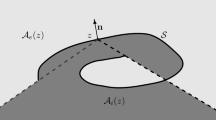Abstract
The Riemann curvature tensor is constructed using the Clifford-Dirac geometric algebra and division-algebraic operator structure.
Similar content being viewed by others
Notes
Ref. [28], p. 89.
Ref. [1], Ch. 3 & Sec. 3.3.
Ref. [17], Secs. 11.5 & 24.6.
See Ref. [23], Sec. III, for the step-by-step derivation, which results in Eq. (8) herein.
See, e.g., Ref. [3], Eqs. (9.29)–(9.30).
Ref. [2], p. 246.
See, e.g., Ref. [7], p. 404.
Ref. [13], p. 224.
Ref. [2], pp. 403–405.
Ref. [20], Sec. 6.2, p. 155: Any symmetric matrix can be transformed into a diagonal matrix with main diagonal \(\pm 1\) entries.
In like manner the 8-component strong interaction gauge field: \(G_{\mu }^{a}\mid a:1\rightarrow 8\), requires an analogous 8-component operator, which has been constructed (Ref. [26], Sec. 3.3).
See, e.g., Ref. [7], p. 404, for the component expression of \(\textbf{R}\) in the \(\{\partial _{\mu }\}\) basis.
References
Ablamowicz, R., Sobczyk, G.: Lectures on Clifford, Geometric Algebras and Applications. Birkhauser, New York (2004)
Baez, J., Muniain, J.P.: Gauge Fields. Knots and Gravity. World Scientific Publishing, Hackensack (2013)
Bailin, D., Love, A.: Introduction to Gauge Field Theory, rev Taylor & Francis Group, Philadelphia (1993)
Belishev, M.I., Vakulenko, A.F.: On algebras of harmonic quaternion fields in \({\mathbb{R}}^{3}\). arXiv:1710.00577v3 [math.FA] (2007)
Conway, J.H., Smith, D.A.: On Quaternions and Octonions. CRC Press, Boca Raton (2003)
Dixon, G.M.: Division Algebras: Octonions, Quaternions, Complex Numbers and the Algebraic Design of Physics. Kluwer Academic Publishers, Norwell (1994)
Fecko, M.: Differential Geometry and Lie groups for Physicists. Cambridge University Press, New York (2011)
Graff, B.: Quaternions and dynamics. arXiv:0811.2889v1 [math.DS] (2008)
Griffiths, D.: Introduction to Elementary Particles, 2nd rev Wiley-VCH, Weinheim (2008)
Hasiewicz, Z., Kwaśniewski, A.K., Morawiec, P.: On parallelizable spheres, division algebras and Clifford algebras. Rep. Math. Phys. 23, 2 (1986)
Hurwitz, A.: Über die Composition der quadratischen Formen von beliebig vielen Variabeln, Nachr. Ges. Wiss. Göttingen, 309–316 (1898)
Krishnaswami, G.S., Sonakshi, S.: Algebra and geometry of Hamilton’s quaternions. Resonance 21, 529–544 (2016)
Maia, M.D.: Geometry of the Fundamental Interactions. Springer, New York (2011)
Misner, C.W., Thorne, K.S., Wheeler, J.A.: Gravitation. Princeton University Press, Princeton, New Jersey (2017)
Nakahara, M.: Geometry, Topology and Physics, 2nd edn. IOP Publishing Ltd. (2003)
Okubo, S.: Introduction to Octonion and Other Non-Associative Algebras in Physics. Cambridge University Press, Cambridge (2005)
Penrose, R.: The Road to Reality: A Complete Guide to the Laws of the Universe. Vintage Books, New York (2004)
Quigg, C.: Gauge Theories of the Strong, Weak, and Electromagnetic Interactions, 2nd edn. Princeton University Press, Princeton (2013)
Ramond, P.: Group Theory: A Physicist’s Survey. Cambridge University Press, Cambridge (2010)
Schutz, B.F.: A First Course in General Relativity. Cambridge University Press, Cambridge (2006)
Weinberg, S.: Gravitation and Cosmology: Principles and Applications of the General Theory of Relativity. Wiley, New York (1972)
Woit, P.: Quantum Theory. Groups and Representations. Springer, Switzerland (2017)
Wolk, B.: An alternative derivation of the Dirac operator generating intrinsic Lagrangian local gauge invariance. Pap. Phys. 9, 090002 (2017)
Wolk, B.: An alternative formalism for generating pre-Higgs \(SU(2)_{L}\otimes U(1)_{_{Y}}\) electroweak unification that intrinsically accommodates \(SU(2)\) left-chiral asymmetry. Phys. Scr. 94, 025301 (2019)
Wolk, B.: The underlying geometry of the Standard Model of particle physics: \(SU(2)\otimes U(1)\). Int. J. Mod. Phys. A 35, 2050037 (2020)
Wolk, B.: The underlying geometry of the Standard Model of particle physics: \(SU(3)\). Adv. Appl. Clifford Algebra 31, 26 (2021)
Wolk, B.: Building the Standard Model particles and fields within a sphere fiber bundle framework. Phys. Open 15, 100153 (2023)
Zee, A.: Quantum Field Theory in a Nutshell. Princeton University Press, Princeton (2003)
Author information
Authors and Affiliations
Contributions
The author did not receive support from any organization for the submitted work.
Corresponding author
Ethics declarations
Conflict of interest
The author has no competing or conflicting interests to declare that are relevant to the content of this article.
Funding
The author has no relevant financial or non-financial interests to disclose.
Additional information
Communicated by Uwe Kaehler.
Publisher's Note
Springer Nature remains neutral with regard to jurisdictional claims in published maps and institutional affiliations.
Rights and permissions
Springer Nature or its licensor (e.g. a society or other partner) holds exclusive rights to this article under a publishing agreement with the author(s) or other rightsholder(s); author self-archiving of the accepted manuscript version of this article is solely governed by the terms of such publishing agreement and applicable law.
About this article
Cite this article
Wolk, B.J. A New Way to Construct the Riemann Curvature Tensor Using Geometric Algebra and Division Algebraic Structure. Adv. Appl. Clifford Algebras 33, 42 (2023). https://doi.org/10.1007/s00006-023-01286-8
Received:
Accepted:
Published:
DOI: https://doi.org/10.1007/s00006-023-01286-8




